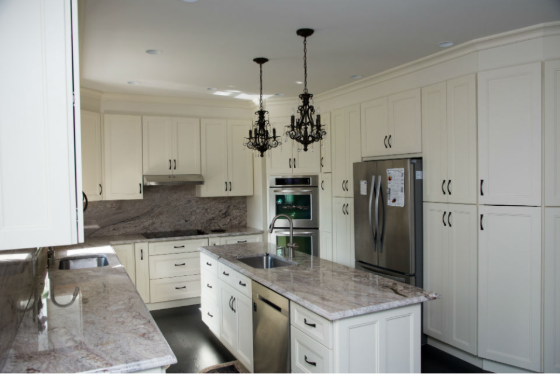Table of Contents
When designing or remodeling a kitchen, one of the most important decisions you’ll make is choosing the right kitchen countertop. As one of the most frequently used surfaces in any home, the countertop plays a central role in both the aesthetic and functional aspects of your kitchen. Whether you’re preparing meals, entertaining guests, or doing homework with your kids, the countertop is always in use.
With numerous options available in terms of material, style, and cost, it’s essential to understand what’s on the market and what best suits your lifestyle and budget. This guide explores the most popular kitchen countertop materials, their benefits and drawbacks, current design trends, and tips for making the best selection.
Why Kitchen Countertops Matter
Countertops are more than just work surfaces—they help define the kitchen’s look and feel. The right countertop can:
- Improve kitchen functionality
- Set the tone for the design style
- Add value to your home
- Withstand wear and tear from daily use
Because countertops are a long-term investment, choosing wisely can prevent costly replacements or frequent maintenance down the road.
Popular Kitchen Countertop Materials
There’s no one-size-fits-all option when it comes to countertops. Here are the most commonly used materials and what you should know about each:
1. Quartz (Engineered Stone)
Pros:
- Non-porous and resistant to stains, scratches, and bacteria
- Low maintenance
- Available in many colors and patterns
Cons:
- Typically more expensive than other materials
- Not as heat-resistant as natural stone
Quartz is a favorite among homeowners due to its durability and sleek, uniform appearance. It mimics the appearance of natural stone but requires significantly less maintenance.
2. Granite
Pros:
- 100% natural stone with unique patterns
- Highly durable and heat-resistant
- Adds resale value
Cons:
- Requires periodic sealing
- It can be heavy and needs professional installation
Granite offers a luxurious, timeless appearance and is renowned for its exceptional strength. No two granite slabs are exactly alike, which gives your kitchen a unique touch.
3. Marble
Pros:
- Elegant and visually striking
- Cool surface ideal for baking
Cons:
- Prone to scratches, stains, and etching
- High maintenance and cost
Marble is a favorite for classic and high-end kitchens, but it requires more care to maintain its pristine surface.
4. Laminate
Pros:
- Very affordable
- Available in a wide variety of colors and styles
- Lightweight and easy to install
Cons:
- Not heat-resistant
- Can scratch or chip easily
Laminate has come a long way in design and quality, making it a great choice for budget-friendly or rental property kitchens.
5. Butcher Block (Wood)
Pros:
- Warm, natural appearance
- Can be sanded and refinished
- Great for prep areas
Cons:
- Requires regular sealing
- Prone to water damage and scratches
Butcher block adds warmth and character to a kitchen and is often used for islands or accent areas rather than the entire countertop.
6. Concrete
Pros:
- Customizable in color, shape, and texture
- Strong and heat-resistant
Cons:
- Can crack over time
- Needs sealing to prevent stains
Concrete is ideal for industrial or modern kitchens, offering a sleek and bold alternative to traditional stone surfaces.
7. Solid Surface (e.g., Corian)
Pros:
- Seamless joints and integrated sinks
- Easy to repair scratches
- Wide range of colors
Cons:
- Not as heat- or scratch-resistant as stone
- Can look less natural
Solid surfaces are great for contemporary kitchens and homeowners who prefer clean lines and smooth textures.
Factors to Consider When Choosing a Kitchen Countertop
1. Lifestyle
Do you cook frequently? Have children? Are you likely to spill wine, oil, or sauces? Choose a material that aligns with your kitchen habits.
2. Budget
Countertop prices can range from $10 per square foot (for laminate) to over $150 per square foot (for high-end quartz or marble). Know your budget and prioritize accordingly.
3. Maintenance
Low-maintenance materials, such as quartz and solid surfaces, are ideal for busy households. Natural stone, like marble or granite, requires more care.
4. Design Aesthetic
Your countertop should complement your cabinetry, flooring, and backsplash. Consider color, finish (matte, polished, textured), and edge profiles to create a cohesive look.
5. Installation
Some materials are easier to install than others. DIY-friendly options include laminate and butcher block, while stone and concrete typically require professional installation.
Current Countertop Trends
- Waterfall edges: Countertops that extend vertically down the sides of islands or cabinets.
- Mixed materials: Combining two types of countertops, such as quartz on the main counters and butcher block on the island.
- Bold veining: Quartz and marble designs with dramatic veining are increasingly popular.
- Matte finishes: Softer, less reflective surfaces are trending over traditional glossy looks.
Final Thoughts
Choosing the right kitchen countertop involves a balance of style, practicality, and budget. With the wide variety of materials and finishes available today, you can find a solution that perfectly suits your cooking habits, design preferences, and lifestyle needs.
Take time to explore samples, visit showrooms, and compare materials before making your decision. A well-chosen countertop can elevate your kitchen for years to come—both in function and in beauty.
